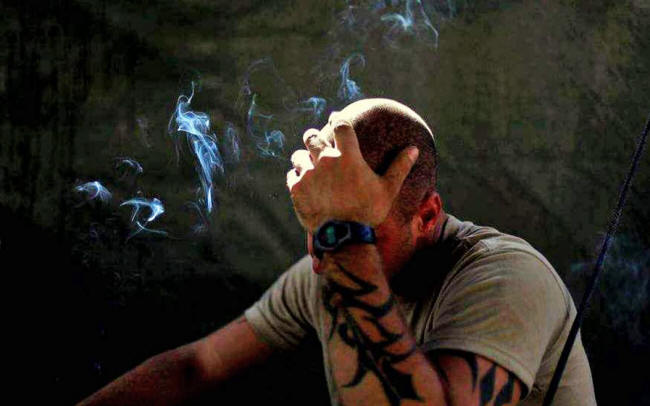|
from
TheLastAmericanVagabond Website Sgt. Jacob Hayes, 25, of Welcome Md., of the U.S. Army’s 2nd Platoon Apache Company of 2nd Battalion 87th Infantry Regiment, part of the 3rd Combat Brigade 10th Mountain Division based out of Fort Drum, N.Y., smokes at Combat Outpost Tangi in Afghanistan’s Wardak Province. Apache company lost 22 soldiers to injuries and one killed on a month that saw 48 IED’s, 7 that were attacks, 41 diffused or destroyed in that timeframe.
David
Goldman | AP the jump in young veteran suicides an "urgent crisis," it unfortunately seems to be a crisis with no end in sight until the country is finally forced to reckon with its dark legacy of regime-change wars and military occupations around the world...
New data released Wednesday by the Department of Veterans Affairs has shown that the suicide rate among young military veterans continues to climb, despite a decline in the overall suicide rate among U.S. military veterans, amid department efforts to combat the problem.
The new data was made available in the VA's National Suicide Data Report, which found that, in 2016, 6,079 veterans ended their own lives compared to 6,281 in 2015.
However, the suicide rate for veterans between the ages of 18 and 34 increased from 40.4 deaths per 100,000 veterans in 2015 to 45 in 2016, four times higher than that of other age groups.
Notably, veterans below the age of 35 were the only age group that saw an increase in suicides from 2015 to 2016. The suicide rate was even greater for young female veterans.
The report also noted that veterans accounted for 14 percent of all suicides in the U.S. in 2016, even though veterans account for only 8 percent of the national population, with more than 6,000 veterans committing suicide every year for the past decade.
On a related note, the suicide rate in the U.S. has increased nationwide in recent years, rising nearly 30 percent since 1999.
Joe Chenelly, the executive director of the national veterans group AMVETS, called the revelation of increasing suicides among young veterans a,
Chenelly also pointed out that these young veterans are those of the "post-9/11 era," meaning that many of the veterans affected served in Afghanistan - now the longest-running war in U.S. history - or in Iraq.
"More than any government has the right to demand"
America's post-9/11 wars, Iraq and Afghanistan in particular, have seen a record number of veterans diagnosed with post-traumatic stress disorder (PTSD), which affects one in five Iraq and Afghan war veterans.
There is a clear correlation between the increase in PTSD cases and the suicide epidemic among veterans, as the suicide rate among veterans has reached its highest level since those two wars began a decade ago.
While some experts have blamed the burden of repeat deployments, most remain "baffled" by the rise.
Suicide notes from young veterans who have chosen to end their lives suggest that certain acts they were ordered to commit by their superiors while serving overseas were often to blame for their tragic decision.
For instance, the suicide note of Daniel Somers, an Iraq war veteran who took his own life at age 30, stated that his PTSD was largely the result of having been ordered to,
Somers noted that,
Indeed, some of the atrocities that have been conducted by U.S. troops in Iraq include orders to slaughter all "military age men" in a given area, torturing detainees, raping children, massacring groups of civilians, and sodomizing prisoners with broom sticks. Later on in his final letter, Somers questioned the purpose of the war that caused his suffering:
Beyond the country's leaders at the time the wars began, Somers' suicide note also placed blame on U.S. government institutions.
He wrote:
Indeed, veteran addiction to opioids is a major problem, which - like the national opioid crisis and the veteran suicide crisis - has been on the rise since the wars in Afghanistan and Iraq.
National media reports in the U.S. have blamed the Department of Veterans Affairs for helping to fuel the national opioid epidemic as well as the epidemic of opioid use among veterans.
While the VA report may call the jump in young veteran suicides an "urgent crisis," it unfortunately seems to be a crisis with no end in sight until the country is finally forced to reckon with its dark legacy of regime-change wars and military occupations around the world...
|


